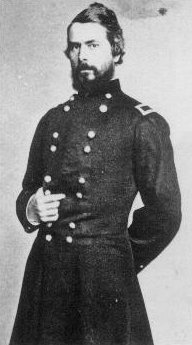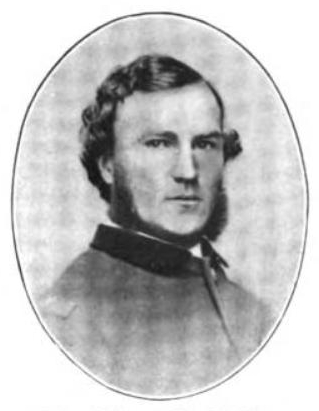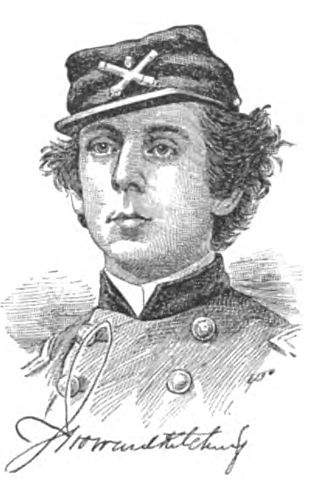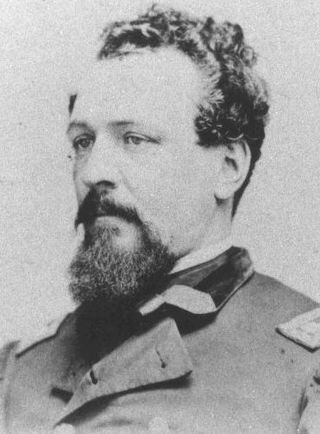
XXII Corps was a corps in the Union Army during the American Civil War. It was created on February 2, 1863, to consist of all troops garrisoned in Washington, D.C., and included three infantry divisions and one of cavalry. Many of its units were transferred to the Army of the Potomac during Grant's Overland Campaign.

Samuel Jones was a major general in the Confederate States Army during the American Civil War. At the midpoint of the war, he commanded the Department of Western Virginia, defending the Virginia and Tennessee Railroad and the vital salt mines. Later he commanded the district of South Carolina.

Truman Seymour was a career soldier and an accomplished painter. He served in the Union Army during the American Civil War, rising to the rank of major general. He was present at the Battle of Fort Sumter. He commanded the Union troops at the Battle of Olustee, the only major Civil War battle fought in Florida.

Thomas Casimer Devin was a United States Army officer and general. He commanded Union cavalry during the American Civil War and during the Indian Wars.

John Irvin Gregg was a career U.S. Army officer. He fought in the Mexican–American War and during the American Civil War as a colonel and near the end of the war as a brevet general in the Union army. In 1866, he was nominated and confirmed as a brevet major general of volunteers and a brevet brigadier general in the Regular Army, both to rank from March 13, 1865.

George Childs Burling was a United States Union Army officer during the American Civil War, serving mostly as colonel and commander of the 6th New Jersey Volunteer Infantry. Burling was born in Burlington County, New Jersey, raised on his father's farm and educated at a private school in Norristown, Pennsylvania. He was a coal merchant and a militia officer before the war. Burling's militia company was mustered into the volunteer service for a three-month term in July 1861, but it became company F of the 6th New Jersey with a three-year enlistment on September 9, 1861. Burling became the regiment's major on March 19, 1862, and lieutenant colonel on May 7 of that year. Burling was wounded at the Second Battle of Bull Run in August 1862.

Eli Long was a general in the Union Army during the American Civil War.

The 1st Michigan Sharpshooters Regiment was an infantry regiment that served in the Union Army's Army of the Potomac during the American Civil War.

Edward Winslow Hincks was a career United States Army officer who served as a brigadier general during the American Civil War.

James Glas Grindlay was a Union Army officer in the American Civil War and a recipient of the United States military's highest decoration, the Medal of Honor, for his actions during the Battle of Five Forks. He served with the 146th New York Volunteer Infantry Regiment and commanded that unit for the last year of the war. He twice briefly led his brigade after his superior officers became casualties, and was brevetted brigadier general shortly before the end of the conflict.

William Stowell Tilton was an American businessman and soldier who led a regiment, and occasionally a brigade, in the Army of the Potomac during the American Civil War. He and his men were heavily engaged in the Battle of Gettysburg, where Tilton's performance created controversy.

Robert Ogden Tyler was an American military officer in the Union Army during the American Civil War. He graduated from the United States Military Academy in 1853 and fought in the Yakima War and the Utah War. He commanded the Artillery Reserve in the Army of the Potomac at the Battle of Gettysburg in July 1863, where his artillery batteries played an important role in the Union victory. Tyler also led a division of heavy artillery turned infantry during the Overland Campaign in 1864. He was severely wounded at the Battle of Cold Harbor and served in administrative duties for the remainder of the war.

James Winning McMillan was an American soldier who fought during the Mexican–American War and served as a Union Army general during the American Civil War.
Samuel Perkins Spear was an American soldier who saw combat in the Seminole Wars, the Mexican–American War, and the Civil War.

John Irvin Curtin was a cousin of Pennsylvania governor Andrew Gregg Curtin. He led a regiment and then a brigade in the American Civil War.

John Howard Kitching often referred to as J. Howard Kitching, was an officer in the Union Army during the American Civil War. He served in the cavalry, artillery and infantry in the Army of the Potomac and Army of the Shenandoah. He received a posthumous promotion to brevet brigadier general after being mortally wounded at the Battle of Cedar Creek.

Oliver Edwards was a machine company executive, an inventor, and a volunteer officer in the Union Army during the American Civil War.

William Stephen Walker was a Confederate States Army brigadier general during the American Civil War. He was born in Pittsburgh, Pennsylvania, but was raised by Robert J. Walker, his uncle, who was a Secretary of the Treasury and U.S. Senator. Walker served as a first lieutenant in the United States Army during the Mexican–American War from 1847 to 1848. He was discharged in 1848. Walker rejoined the army as captain in the 1st U.S. Cavalry Regiment on March 3, 1855, and served until he resigned on May 1, 1861. Walker was wounded in the left arm and lost his left foot during the Battle of Ware Bottom Church during the Overland Campaign. After the war, he lived at Atlanta, Georgia.
Joseph Nelson Garland Whistler was a career United States Army officer. He served in the Mexican–American War and received a brevet appointment for distinguished service in the Battle of Contreras and the Battle of Churubusco. At the beginning of the American Civil War, Whistler was among the U.S. Regular Army officers taken prisoner by Confederates in Texas in April 1861 and paroled but was not exchanged until August 15, 1862. In 1863, he became colonel of the 2nd New York Heavy Artillery Regiment. He received a promotion and four brevet appointments in the regular army for his service during the Overland Campaign, specifically the Battle of North Anna, and the Siege of Petersburg, specifically the Second Battle of Petersburg. He was nominated on January 13, 1866 and confirmed on March 12, 1866 for appointment to the grade of brevet brigadier general of volunteers, to rank from March 13, 1866. He retired in on October 19, 1886 as colonel of the 15th U.S. Infantry Regiment.

James Gwyn was an officer in the Union Army during the American Civil War. He immigrated at a young age from Ireland in 1846, initially working as a storekeeper in Philadelphia and later as a clerk in New York City. At the onset of the war, in 1861, he enlisted and was commissioned as a captain with the 23rd Pennsylvania Volunteer Infantry. He assumed command of the 118th Pennsylvania Regiment in the course of the war. Gwyn led that regiment through many of its 39 recorded battles, including engagements at Seven Pines, Fredericksburg, Shepherdstown, Five Forks, Gettysburg, and Appomattox Court House.


















